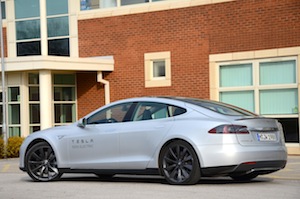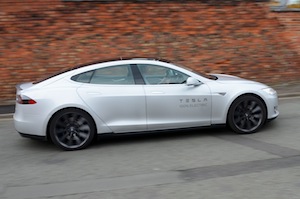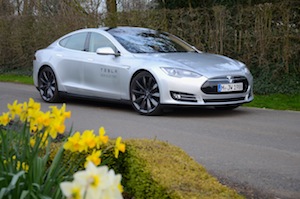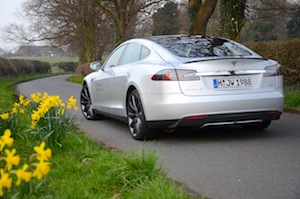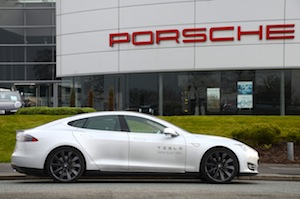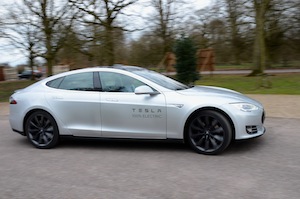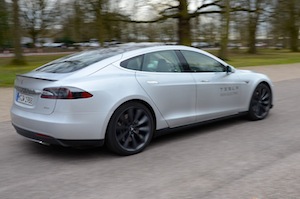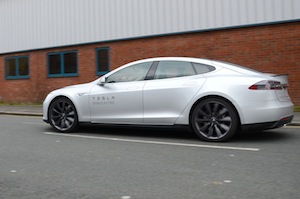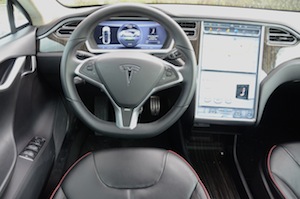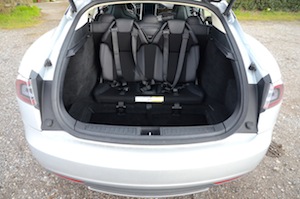2014 Tesla S GreenCarGuide Review +VIDEO
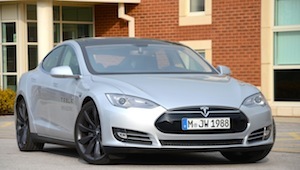 |
 |
From www.greencarguide.co.uk
14 April 2014
By Paul Clarke
• SEE ALSO: Tesla News From The Auto Channel
• SEE ALSO: Exclusive Interview with the Boss of Tesla's Sales Efforts - VIDEO FEATURE
2014 Tesla Model S
Eco Facts
Model/Engine size:†Model S Performance
Fuel:†Electric
Fuel economy combined:†N/A mpg
Green-Car-Guide rating:†10/10
Introduction
The Tesla Model S is probably the biggest revolution in motoring in the last 100 years, as Tesla has appeared from nowhere and produced an amazing all-electric sports saloon with a range of 300 miles – and it can even seat up to 7 people.
Summary†
• Amazing to drive, with incredible performance
• Zero tailpipe emissions
• Range of up to 300 miles
• Expensive, but worth it
Background
Tesla has existed as a company for barely ten years. Its only previous product has been the Roadster, an all-electric sports car based on the Lotus Elise. This was designed to get people to wake up and be aware of the company. Now we have the Tesla Model S, an all-electric sports saloon with a range of up to 300 miles. The major car manufacturers of the world should be very, very worried.
Design & Engineering
To most people, the Tesla Model S looks like some sort of five-door Aston Martin or Jaguar; they certainly like its design. However when they see the interior – in particular the dashboard, which is primarily comprised of a huge 17-inch iPad-style touchscreen – they’re completely blown away. Just to finish them off, you can tell them it’s a seven-seater. They’ll think you’ve been drinking copious quantities of alcohol and that you’ve lost the plot, until you lift the tailgate and show them two seats in the boot. They’re only suitable for children (it’s called a ‘5+2’ seating configuration), but the other five seats are all capable of accommodating adults in relative comfort.
You can even go one stage further and show them under the bonnet, where, incredulously, there’s no engine. Instead, there’s yet more storage space. They’ll think this is some sort of transport from a more advanced planet – a car that’s powered by an invisible powertrain.
The reality is that the major powertrain component, the battery, is under the floor. It’s a pretty huge battery, yet the seats aren’t perched high up like they are in an SUV or some MPVs – the driving position is genuinely low and sports saloon-like.
The battery being under the floor, between the axles, explains why there’s a huge amount of space in the car. There’s no engine and gearbox to package everything else around. This architecture also results in an extremely low centre of gravity, which assists the car’s handling.
Tesla Model S Driving Experience
If people look at the Model S and think it’s from another planet, then wait until they experience how it drives. The process starts with walking up to the Model S and, when the key fob becomes in range, the door handles magically extend outwards. The car also switches itself on automatically as you sit in the driver’s seat, so all you do is engage Drive on the steering wheel-mounted gear selector, and you’re off. And boy, are you off. Floor the accelerator and you’ll experience spaceship-like acceleration. The Model S Performance, as tested, has a 0-60 mph time of 4.2 seconds, and with 100% torque available at virtually all times, the sensation is like no petrol or diesel car. And of course it’s quiet – eerily quiet.
Not only does the Model S operate in near silence, it’s also extremely comfortable, with a cosseting ride. It genuinely is a luxury sports saloon.
With the battery weight so low down, and almost a 50/50 front/rear weight distribution, the rear-wheel drive handling is highly impressive. However this is a heavy car – it weighs 2,100kg (it would be heavier if it didn’t have a lightweight aluminium body) – and so if you’re expecting agile handling, you’re looking at the wrong car. It’s also a very wide car, as you’ll discover if you have to squeeze through any gaps with restricted width.
With all that torque being delivered from standstill, the traction control system has to work hard to keep the rear end in check under harsh acceleration – especially in the wet.
Everything sounds great, but surely there are some compromises to the driving experience? Well, if you were to push us, the only issue is that the steering isn’t the sharpest in class. You can choose from three settings via the touch screen – Comfort, Normal, and Sport. Comfort felt like an ocean liner, Normal was acceptable, but Sport was our default choice.
The touchscreen is highly impressive and generally works well, although the navigation through the large amount of information could be made easier. You can summon up Google maps or even watch the BBC news while you’re driving – not that this is recommended of course. Pretty much everything is operated via the touch screen – from the release of the charging flap to the opening of the sunroof. In fact there are only two buttons on the dashboard – one for the hazard lights, and one for the glove box. Thankfully, and unlike other cars that have all their controls on a touchscreen – such as the new Peugeot 308 – the heating and ventilation controls are always on show at the bottom of the screen.
Many people believe that a guaranteed part of the driving experience of an electric car is range anxiety. This never happened with the Tesla. On most days the car covered around 50 miles, much of this comprised of giving demonstration drives to a huge queue of intrigued friends and colleagues. The car was plugged in at night and the range was always at least 200 miles the next morning. However the last day with the car entailed journeys totalling around 150 miles, most of it on motorways. There’s no other electric car that could achieve such distances at such speeds, but the Tesla finished the day with 50 spare miles of range.
It’s also the case that the range of most electric cars plummets when driving at 70mph on the motorway, but there seems little difference between driving the Tesla on motorways and other roads.
Tesla Model S Economy and Emissions
It seems incredible that a car with this much performance requires no petrol or diesel and has zero tailpipe emissions. It also seems strange that after a number of years of manufacturers bringing electric cars to market with ranges typically maxing out at around 100 miles, the Tesla has a range of up to 300 miles.
Of course the energy for electric cars has to come from the electricity network. This means that you’ll be paying for electricity to recharge the car, but this should be much cheaper than petrol or diesel – probably around one-fifth of the cost. If you choose a renewable energy tariff, then the Model S should emit zero g/km CO2 in use and also in terms of its original energy generation.
Ideally you would have a recharging wall box installed at your house, although it is possible to recharge from a standard domestic three-pin socket (230V/13A/3kW). This is not recommended, and it would take a long time to recharge from empty to full, as you’ll only gain 8 miles of range per hour of charge. Using the mobile connector, the car will gain up to 34 miles of range per hour of charge (400V/16A/11kW).
Using 400V/32A/22kW charging via a wall connector coming to UK households in late 2014, the car will gain up to 68 miles of range per hour of charge.
Tesla is also installing a ‘supercharger’ network around the UK and Europe, where Tesla owners can recharge for free to help facilitate longer road trips. A supercharger can charge about half the battery in 20 minutes. Supercharging is included in the 85 kWh Performance version, but this capability is a £1,800 option for the 60 kWh version (or £2,300 if you decide to retro-fit this after buying the car).
Price, Equipment and Model Range
The Model S is offered with three battery options:
• 60 kWh, 440 Nm torque, 242 mile NEDC range, and a 0-62mph time of 5.9 seconds (£50,280)
• 85 kWh, 440 Nm torque, 312 mile NEDC range, and a 0-62mph time of 5.4 seconds (£57,680)
• 85 kWh Performance (as tested), 600 Nm torque, 312 mile NEDC range, and a 0-62mph time of 4.2 seconds (£69,080).
The prices above are after the UK government £5,000 Plug-in Car Grant has been applied.
There’s also a Performance Plus model, which is optimised for even better handling. This is an additional £5,500.
There are a number of options, including the rear-facing seats, which cost £2,100.
For company car buyers – presumably the main target market for this car – there is 0% Benefit in Kind. This could save around £5,000 per year in tax for a 40% tax payer compared to a petrol or diesel car of the same value.
And of course there’s no VED to pay. This may be a small financial saving in the big scheme of things, but, psychologically, not having to pay road tax on a car with this level of performance is a huge feel good factor.
If you drive in London, the Model S is exempt from the Congestion Charge – this could save up to around £2,500 per year.
As if all these financial incentives weren’t enough, you also have to remember the savings in fuel costs that you’ll make. This obviously depends on your mileage, but based on the average use of such a car, we’d estimate that you could be saving up to around £4,000 per year on fuel.
If you add up all these savings, the Model S suddenly doesn’t look that expensive.
Conclusion
Once you’ve driven the Model S, it changes your view about all other cars. This is an all-electric sports saloon with a 300-mile range, incredible performance, it’s super-quiet, amazingly refined, and very comfortable. You can even seat up to seven people. You wonder how Tesla – a company that has existed for barely ten years – has done this, and why the more established manufacturers haven’t done this.
Okay, so the Model S may be expensive, but look at it this way – the Model S starts at £50,000, whereas the Mitsubishi i-MiEV – a very small all-electric city runabout with a real-life range of less than 100 miles – cost around £33,000 not too long ago.
While the mainstream manufacturers have been making incremental improvements to their cars for the last 100 years, Tesla has genuinely brought disruptive technology to the market. If this is a taste of things to come, the car industry is about to get very, very exciting.
For anyone who doubts that our future will contain electric cars – and that’s a lot of people – they need to drive the Model S, and they will instantly understand how cars such as this will undoubtedly have a place in the world of motoring.
We have absolutely no hesitation in awarding the Tesla Model S a Green-Car-Guide rating of 10 out of 10.
Car Facts and Figures
Tesla Model S data†
Fuel economy extra urban: N/A mpg
Fuel economy urban: N/A mpg
Test economy: N/A mpg
CO2 emissions: 0 g/km
Green rating: VED band A – £0
Weight: 2,100 Kg
Company car tax liability (2013/14): 0%
Price: £69,080 (after the UK government £5,000 Plug-in Car Grant has been applied)
Insurance group: tbc
Power: 416 hp
Max speed: 130 mph
0-62mph: 4.2 seconds
Charging
11 kW capable on-board charger with the following input compatibility: 85-265 V, 45-65 Hz, 1 phase 40A or 3 phase 16A (Optional 22 kW capable Twin Chargers increases three phase input to 32A and single phase input compatibility to 80A)
Peak charger efficiency of 94%
11 kW capable Universal Mobile Connector, IEC 60309 5 PIN Red 16A/3-phase (400 V) or IEC 60309 3 PIN Blue 32A/single-phase (240 V) adapter
A choice of adapter is available at time of purchase



